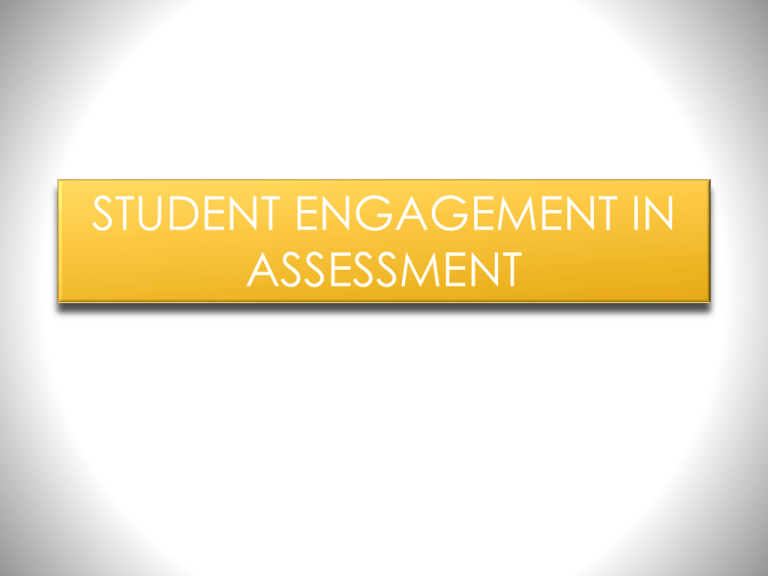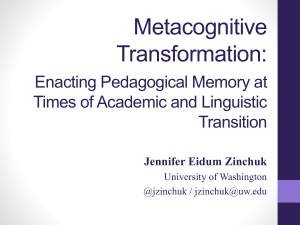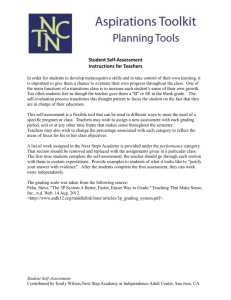STUDENT ENGAGEMENT SELF ASSESSMENT DAY 2
advertisement

STUDENT ENGAGEMENT IN ASSESSMENT L. Cameron 2001 Language Teaching • .. we tend to underestimate the potential for self regulation in our students, seeing them too often as blank sheets to be written on or empty vessels to be filled… …we need to support even our youngest learners to develop awareness of and mobilise their internal resources.. We need to let students into the secret, allowing them to become insiders in the assessment process. We need to make provision for them to become members of the guild of people who can make consistently sound judgments and know why those judgments are justifiable. • Royce Sadler (1998) Discuss / feedback Is this a reasonable expectation? Consider and discuss how it might occur in a stage 1… stage 3 classroom. Where are we in making this happen? WHAT? • students monitor their own progress whilst completing an activity, and then evaluate their achievement on completion • peers are able to provide feedback to other students at strategic points while they are in the process of completing the activity • the teacher is able to provide feedback which students can act on to improve their performance whist completing and after completing Self assessment contributes to student motivation and overall assessment as a learner. WHAT HOW THE STUDENT KNOWS Where they are up to WHY What do students need to engage with when assessing their own learning? • language in criteria and descriptions that they can understand • limited number so students are not overwhelmed • focus on the learning and not on behaviour (eg paying attention, contributing, meeting deadlines etc.) • be supported, where necessary, by examples or work samples which make their meaning clear. (This is probably particularly relevant in the case of rubrics.) • over time engage students in developing criteria, standards, themselves. Students and rubrics or criteria • Supports ongoing monitoring and checking by the students as they are completing the task • At completion of task students can gauge how well they have gone Maths • There is a framework for providing checklists and rubrics feedback both during the task and at the completion. During task feedback allows for improvements • Feedback can be from teacher/s peers and parents DEVELOPING AND ENCOURAGING STUDENT AWARENESS OF THEIR OWN LEARNING – METACOGNITIVE STRATEGIES • understanding and recognising their own thinking processes • What thinking processes would students be using to find main idea? developing self-knowledge that leads to selfregulation • planning how to proceed with an assessment task • monitoring own performance on an ongoing basis • evaluating learning and self as learner • Students with greater metacognitive awareness understand the similarity between the current learning task and previous ones, know the strategies required for successful learning, and anticipate success as a result of knowing how to learn. In order to continue to be successful with tasks, students need to be aware of the strategies that led to their success and recognize the value of using them again. STUDENT SELF ASSESSMENT MATRIX • Consider the two examples . What do they reveal about the students’ understanding of self assessment? Making it happen (q) • Students need to be taught strategies for self monitoring and self assessment. Teachers need to model the techniques eg use of a checklist or rubric, students then try the technique themselves and finally they discuss and review whether and how well the technique worked and what to do differently next time. Students do not learn to assess their learning on their own; they need to be taught strategies for self-monitoring and self-assessment. An effective strategy might be to: • Model using a checklist or rubric to assess a piece of work using think-aloud strategies as you look at each criteria • Students try the technique themselves using a common work sample. • Students review each others’ work and self assessment and make comments • Students discuss whether and how well the technique worked and what to do differently next time The setting of learning targets, or goalsetting, is an intrinsic part of self-assessment. Student self-assessment begins with setting learning targets, collaboratively proceeds through the production of work that aims to achieve those targets, to the assessment of the work to see if it does in fact meet the targets and then, finally, to the setting of new targets or revising ones that were not achieved. Diagrammatically, the process looks like this: Student learning goals S = Specific M = Measurable A = Achievable or Attainable R = Relevant T = Time-bound Specific The learning target must be specific rather than general: 'I will include a topic sentence in each paragraph' rather than 'I will improve my paragraphs.‘ Measurable It must be possible to know whether the learning target has been accomplished, so there needs to be some way of measuring this. Achievable The achievement of the learning target must be something the student is capable of attaining. Where the prospect of achievement seems daunting, the learning target can be broken down into a series of steps. For example, instead of a learning target that states 'I will use correct spelling', it is better to concentrate on the use of individual spelling strategies. Relevant The learning target needs to be significant and relevant to the student's present learning. If students are left to set learning targets without any guidance, at least initially, there is a danger that such targets will be less relevant. Time-bound Students should specify when they aim to achieve the target. Time-bound learning targets are easier to evaluate and track than those which have no particular time period attached to their achievement. Time management Students' ability to manage and organise their own time in order to complete set tasks is a crucial aspect of self-assessment. Schools recognise this when they institute a variety of structures to support students developing independence in this area; the student diary is one example. In the case of extended projects students can be assisted to manage their time if teachers 'chunk' the work into discrete sub-tasks. GENERAL STUDENT SELF ASSESSMENT universal criteria that apply to all of their thinking, irrespective of the particular task. For example, they should always be striving for clarity, accuracy, and significance. Of course, they also need to adjust their thinking to the precise demands of the question or task before them. Does this task require the student to analyse or synthesise One simple structure to use in attending to this dual need is to provide students a set of performance criteria that apply to all of their work, criteria that they will be using over and over. Then, make specific provision for encouraging students to think in a focused way about the particular demands of any given task or question before them. think in ways that are imaginative, creative, interpretive and critical gain independence from thinking imaginatively, interpretively and critically • Critical and creative thinking [CCT] • Students develop critical and creative thinking as they learn to generate and evaluate knowledge, ideas and possibilities, and employ these skills when seeking new pathways or solutions. …..provide students with opportunities to think in ways that are critical and creative using information and ideas and arguments ……….evaluate their own work and the work of others, and plan for future learning. These skills are integral to activities that require reason, logic, imagination and innovation. In learning to think broadly and deeply students use reason and imagination to direct their thinking for different purposes. Metacognition is “thinking about thinking” (Rolheiser, Bower, & Stevahn, 2000, p. 32). • Developing reflective processes can lead to improved metacognition. Rolheiser and colleagues note that when students develop their capacity to understand their own thinking processes, they are better equipped to employ the necessary cognitive skills to complete a task or achieve a goal. They also note that “students who have acquired metacognitive skills are better able to compensate for both low ability and insufficient information” (p. 34). • Developing reflective processes can lead to improved metacognition In a nutshell…. • WHAT I HAVE LEARNT? HOW WELL? WHAT THINKING DID I USE? • WHAT IS STILL DIFFICULT OR CONFUSING? WHERE TO NEXT? To help students determine what they need to do to get there, teachers can ... • collaboratively identify strengths and gaps in student learning through the analysis of a variety of data • help students to develop realistic action plans that are practical and directly linked to the goals that have been selected…. Young students very small • monitor students’ progress as they implement action plans • ask students to review their work to determine what they have learned, how they have learned, and what areas of confusion still exist. Through these forms students assess their progress in knowledge, skills, strategies, processes, and attitudes. • Students can assess their efforts , their participation in a group, their thinking processes, their written assignments and presentations, and their demonstration of skills . • An effective way to foster student selfassessment is to ask the students to develop the criteria for the assessments themselves. To do this, students must analyse each aspect of their learning processes and products, thereby leading to a much deeper understanding. • 20 seconds per day per student • Expect improvement! To help students determine where they intend to go, teachers can ... • develop with students clearly articulated learning targets and provide concrete exemplars of student work; students need to understand what they’re “aiming for” • define good work using language that is meaningful for the learners; ideally, involve students in determining the language that is used • establish what language or symbols will be used for the purposes of reflection and self-assessment, depending on age level and development • model goal-setting for students • monitor the goals that students set for themselves (i.e., that they are meaningful and manageable) • ensure that goals are recorded for future reference • STUDENT SELF ASSESSMENT How do teachers ensure that students who perceive themselves as unsuccessful do not assess themselves harshly and inaccurately? When students self-assess positively, they set higher goals for themselves and commit more personal resources or effort to them (Rolheiser, 1996). Students may self-judge and self-react to achievement results regardless of teacher input. “A stream of negative self assessments can lead students to select personal goals that are unrealistic, adopt learning strategies which are ineffective, exert low effort and make excuses for performance” (Stipek, Recchia, & McClintic, 1992, cited in Ross, 2006, p. 7). Actions teachers can take ... • identify a focus and/or next steps based on identified and understood areas of need in student knowledge/ understanding • encourage students to focus on concrete information rather than past performances or patterns of achievement; self-assessing analytically versus holistically may assist with this process • when responding to students’ self-assessments, give feedback that motivates students to continue their learning; ask them what they think, what helped them, and how they deal with challenges; focus on the positive (Rolheiser et al.,2000, p. 65) Students who can self assess accurately and successfully against the criteria and know their next steps in learning Students who can peer assess accurately and successfully and give feedback against the criteria Teacher Reflection Activity Start small and manageable REFLECTIVE QUESTIONS Do your pictures add meaning to the text? Do you think you collected enough information? Were you happy with your final presentation? MOSTLY SOMEWHAT NEED TO IMPROVE • They will always rate themselves highly … especially the trouble makers! • Kids don’t know how to do this! Teacher demonstrates engaging students in monitoring their own learning Self assessment growth continuum PEER FEEDBACK • Student to student discussion and advice around a task • Criteria form the focus of the discussion • what still needs to be done in order to achieve the success criteria • advice on how to achieve any recommended improvements











